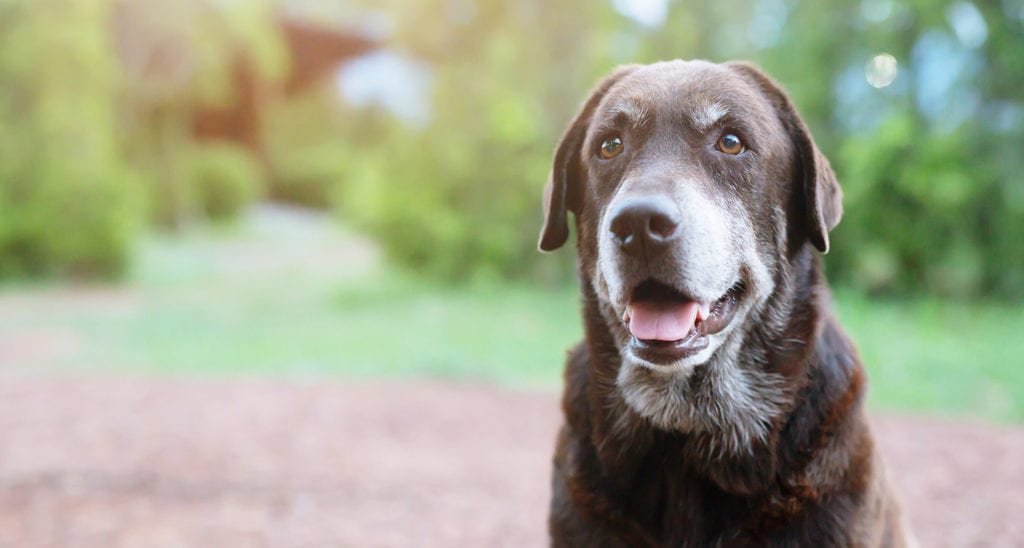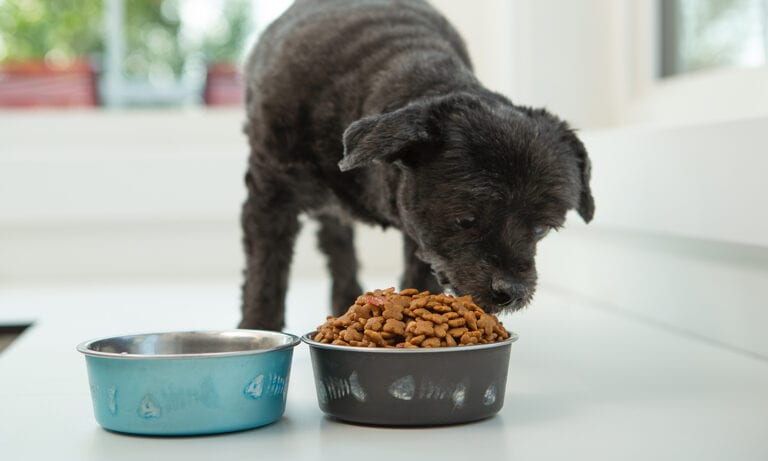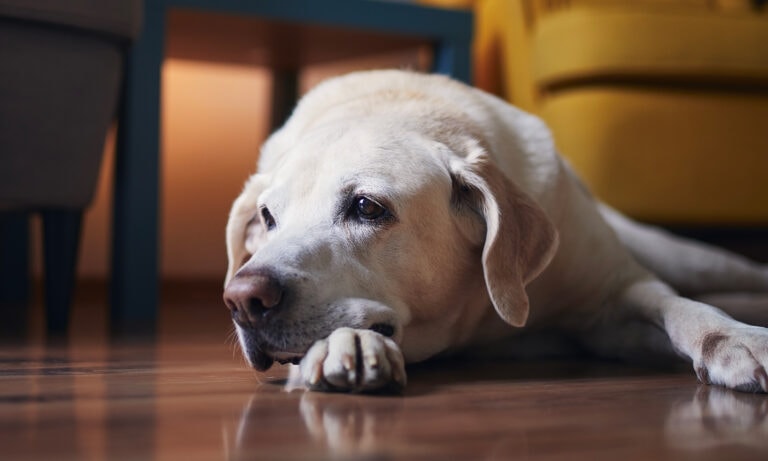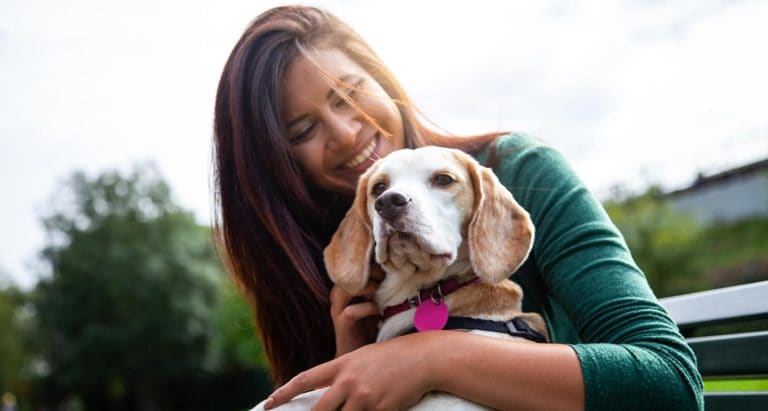While pet parents watch out for their dogs every day, if you have a senior dog you might be hyper-alert to any changes. What does it mean if you notice your dog's spine is showing, or that your loyal friend seems to have difficulty getting up? It can be tricky to tell if a change you see is normal aging or illness, and whether or not it can be helped. So let’s take a tour from nose to tail of a senior dog to see when to be concerned. My own dog, almost 14-year-old Baloo, has volunteered to help.
Dogs are generally considered to be seniors by 7 or 8 years of age. In reality, senior status varies greatly with breed and size. Small and toy breed dogs really aren’t seniors until about 10 years of age. Many giant breed dogs like Great Danes can be considered seniors by 5 years of age. Even with those generalities, it is important to look at your dog as an individual.
Changes To A Dog’s Head
Starting with the nose, most dogs retain their sense of smell until they drop. Scent is a prime sense for dogs, and smelling is often how they perceive the world. This is true for all dogs, from Pugs with short faces to Borzoi with long muzzles. You do want to look at the muzzle for any asymmetry, including lumps, loose lips or growths.
Mild facial paralysis is not uncommon in older dogs. Our Australian Shepherd, Baloo, shows this with the slight droop of the lip on one side and his ear a touch lower. There is no treatment and it does not cause him any problems, except maybe a touch of extra drool over great treats!
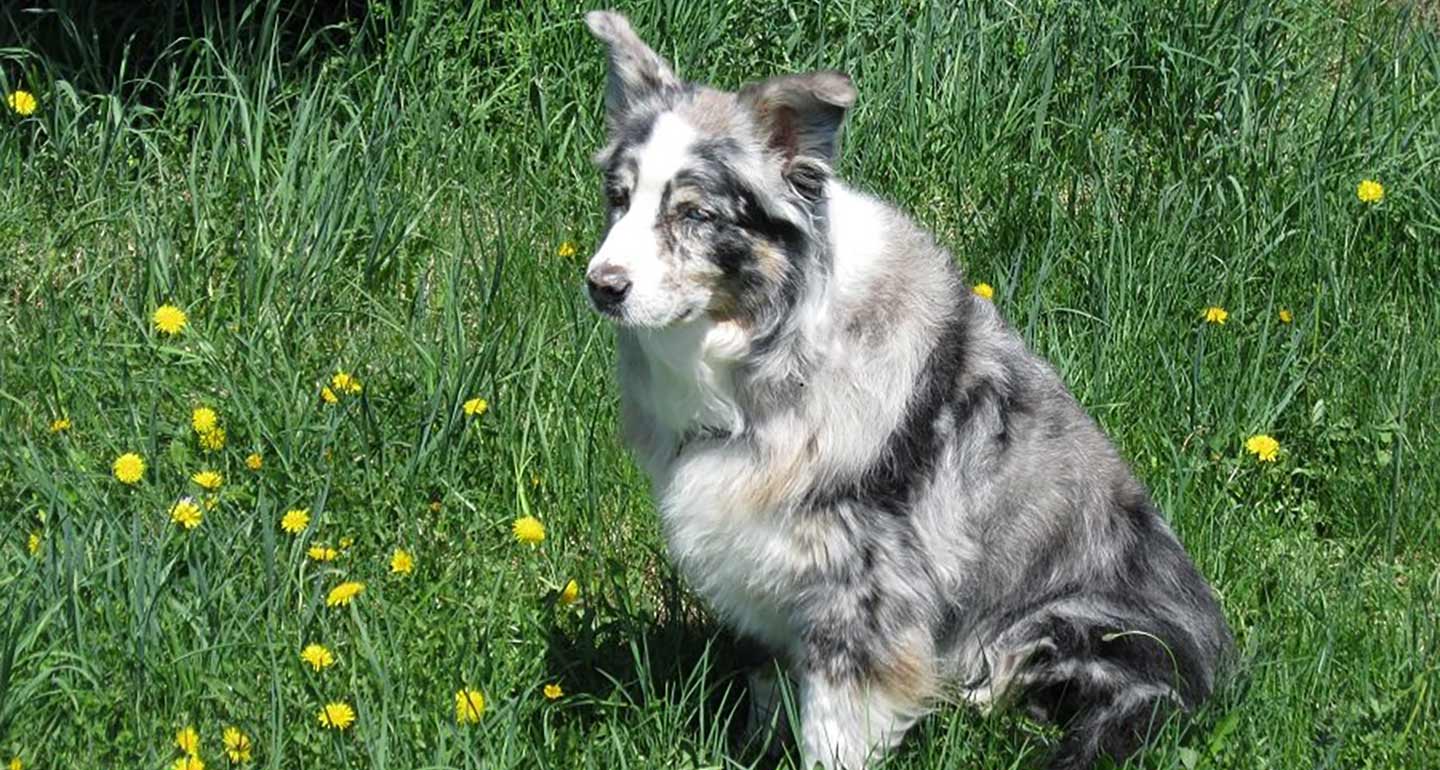
Courtesy of Deb Eldredge, DVM
Tooth And Mouth Problems In Older Dogs
While looking at the muzzle, don’t forget to check out the teeth. Older dogs are prone to tartar buildup and gum disease. This can lead to loose teeth, especially the incisors, right in the front. Teeth may crack or become abscessed with age.
It is well worth the cost to have a full dental cleaning and workup by your veterinarian. Anesthesia these days is quite safe, and with pre-operative blood work, most risks can be minimized. A number of teeth may need to be pulled but once the mouth is healed, dogs eat just fine—even dry kibble. Baloo has had to have a number of teeth pulled over the years for various reasons, including a cracked molar. He still eats his dry dog food just fine and enjoys various chews. Daily tooth brushing keeps his smile bright.
Many families report an increase in activity after an elderly dog has had a dental workup. Dental problems are common in all dogs as they age, but especially in small and toy breeds. Consider bad breath to be a wake-up call for an oral exam. Other signs of trouble include extra drooling, not wanting to eat, ignoring hard chews or any blood from the mouth. Once your dog’s mouth is cleaned up, be sure to start a regular routine of dog dental care. That might include tooth brushing, dog dental chews, dog dental wipes or additives to your pet’s food or water.
Tumors can also show up in the mouth—possibly under the tongue, along the gums or on the lips. Dogs with dark pigment in the mouth are slightly more prone to melanomas. There are many ways to treat these cancers—surgery, radiation, chemotherapy and even a vaccine. You can discuss options with your veterinarian if you need to deal with this problem.
Old Dog Eye And Vision Changes
Your senior dog will almost always show some changes in his eyes and vision. Cataracts are fairly common in senior dogs, but that whitish discoloration you notice may not be a cataract. It could simply be an aging change called nuclear sclerosis. This is a hardening of the lens causing the whitish cast, but it has minimal effect on vision. Your veterinarian can distinguish the two via an ophthalmic exam.
Even with cataracts, there is a great deal of variation as to the effect on vision. If your senior dog develops serious cataracts in both eyes, you may want to consider surgery to restore some vision. Luckily, cataracts are not painful and dogs tend to have wonderful “memory maps,” including scent trails that allow them to negotiate on home turf very well. Sometimes they get around so well that their families don’t notice the vision loss until they rearrange the furniture! Baloo has some nuclear sclerosis but no cataracts, so he gets around just fine visually.
Age Can Cause Hearing Loss
Hearing loss is common in senior dogs. You may notice your dog not coming right away when called (assuming he did have a good recall). Often a sharp whistle or clap will get his attention. You can test hearing in a superficial way at home by dropping something behind your dog. His reaction will give you an idea of his hearing.
If your dog appears to have hearing loss, consider ways to help guide him with dog training for deaf dogs. Yes, old dogs can learn new tricks. Hand signals for behaviors can be helpful. Using a blinking light at night to guide him back in after his elimination trip to the backyard is an easy one. Baloo responds very well to me flicking the backyard light on and off when he needs to come back in. A deaf dog may startle when you come up to him if he is resting or sleeping. With the startle he may even go to snap. To prevent startling a dog with hearing loss, stomp on the floor to cause a vibration as a warning that you are approaching.
One side effect of the hearing changes seems to be changes in the middle and inner ear. Dogs who have never been bothered by thunderstorms may suddenly become thunder phobic. This is generally seen in dogs who are 8 years of age or older. Often the change in behavior goes away with time, but that may take a couple of years. Baloo has shown no storm effects, but my Belgian Tervuren, Dani, was suddenly bothered by storms from 12 to 13 years of age. Then she reverted to her previous calm behavior.
Mental Changes For Senior Dogs
Cognitive issues have been noted in dogs as they age. Your dog may seem to have trouble with commands or act lost out in the yard. He may seem to have lost his “zest” for life. Some dogs show the first signs of cognitive changes as a “sundowner’s syndrome”—having trouble resting at night, pacing or barking uncontrollably. Medical causes should be eliminated first, but if it appears to be purely cognitive, there are supplements that can help.
Read about the signs and treatment of canine cognitive dysfunction.
Senior Dog Warning Signs For Cardiac And Respiratory Trouble
Coughing and a drop in activity level may reflect aging changes in cardiac and respiratory function in your senior dog. Heart problems tend to be quite common in small and toy breed dogs. You might also notice panting, pale or bluish mucous membranes such as the gums, and reluctance to lie down and sleep. Any of these signs should be followed up with a visit to your veterinarian. There are now many options for treating heart problems in senior dogs.
Skin And Coat Changes In Old Dogs
You may notice changes in your dog’s skin and hair coat as he ages. The coat may grow longer but also get dry and brittle. Thinning of the hair coat may reflect a hormonal change. This can be diagnosed by bloodwork at your veterinary clinic. Supplemental hormones may help.
Many dogs become less tolerant of grooming with age. Your groomer may suggest more frequent visits so the time involved is kept shorter. At home, you might want to switch to a wooden pin brush as opposed to one with metal pins. Trimming long feathers off the front and rear legs can help, as well as trimming long hair around the rectum and vulva or penis for hygiene purposes. Doing at least a partial shave may save grooming angst for you and your dog. Dogs like Old English Sheepdogs, Shih Tzu or Poodles who may have been kept in full show coats might really appreciate a cut down at this point in their lives.
Elderly dogs, especially Miniature and Toy Poodles as well as Miniature Schnauzers, are prone to skin growths. These may be small warts, little whitish sebaceous cysts or small lipomas. Your veterinarian will examine them and possibly do a needle biopsy or full surgical biopsy to rule out cancers. In general, small growths that are totally in the skin and can be easily moved around tend to be benign.
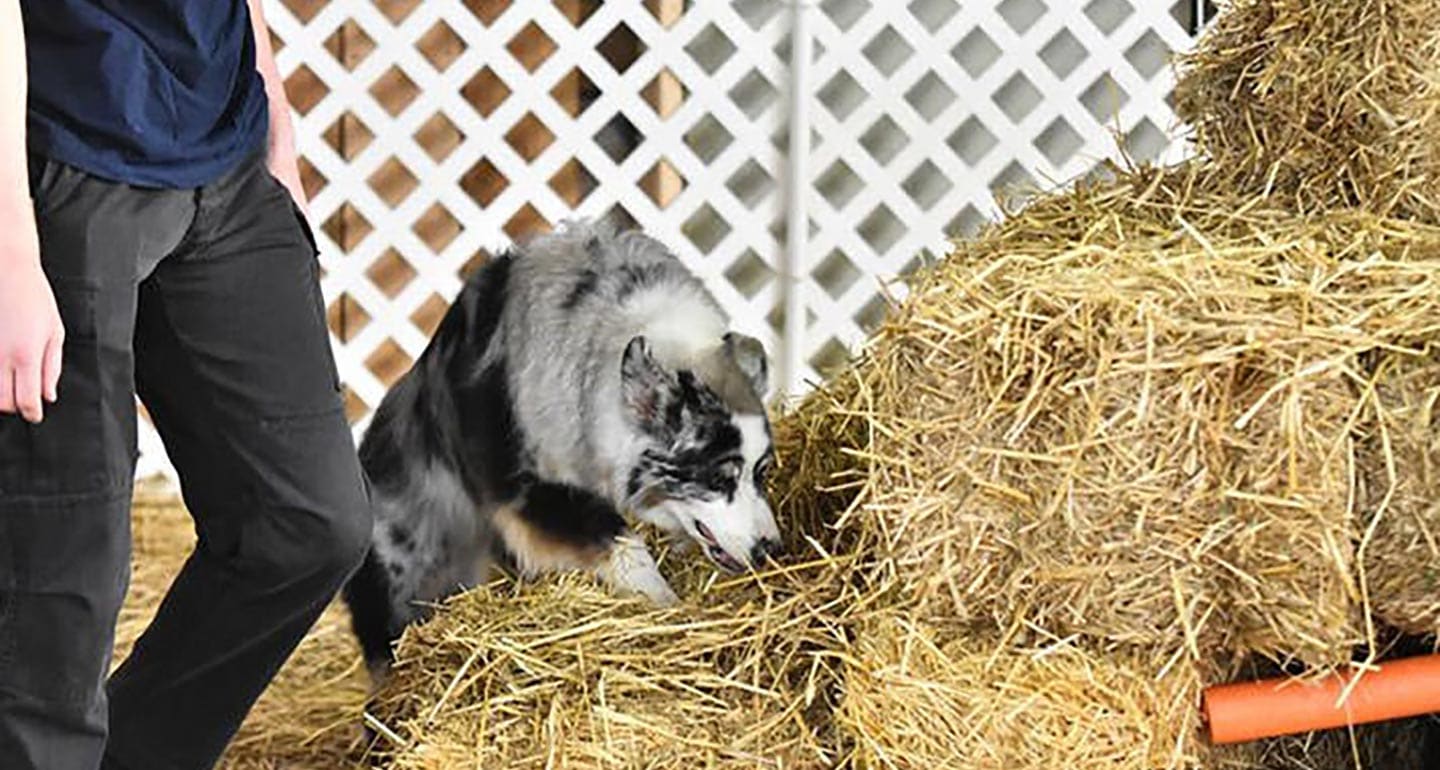
Courtesy of Mike Mulloy
Arthritis in Old Dogs and Other Changes in Mobility
Sadly, many older dogs will show some signs of arthritis. This is most commonly noticed in medium- to giant-sized dogs. Over the years, their joints have taken a lot of wear and tear. Your first hints may be a reluctance to go up or down stairs, hesitation to hop up on the sofa or bed, or refusing to hop into the car. Some dogs simply refuse to take long walks or show a drop in their enthusiasm for games of fetch. It is important to have a veterinary exam to rule out trauma or serious injury. A guideline is that an acute change is most likely an injury while gradual changes in activity are most likely from aging and arthritis.
Don’t despair at the first signs of arthritis. Many dogs respond very well to joint supplements, with pain medications added as needed. Your veterinarian may also suggest some changes in activity, use of ramps and some physical therapy exercises.
A gradual change in mobility not caused by arthritis is degenerative myelopathy, or DM. German Shepherd dogs are the poster breed for this problem, but many breeds and mixes are also susceptible. In simplest terms, DM means the nerves of the spine, starting from the rear forward, gradually degenerate. The flow of information from the legs to the brain and vice versa is slowed down or even stopped. Dogs with DM show a gradual and progressive loss of mobility, starting with the rear legs. You might notice your dog standing with his paw flipped over or keeping his hind legs spread apart to support him.
There is no cure for DM but some medications may slow the spread of the problem. Unlike arthritis, which can be painful, most dogs with DM don’t show pain. This is because the nerves that control pain response are also degenerating. Physical therapy can aid in slowing the progression of this disease. Baloo has some arthritis and very mild DM, but he stays active. He still does barn hunts! He is on joint supplements, and I add pain medications if he acts sore.
A non-traumatic, acute change in mobility seen in elderly dogs is vestibular syndrome. This problem seems to strike medium and large dogs more than smaller canines. With this problem, you may wake up to find your dog unable to get up, walking in circles, walking a bit like a drunken sailor or with his head tilted to the side. The eyes are affected with this problem as well and make rapid movements called nystagmus. Most dogs with vestibular syndrome show some nausea—probably from the eye movements.
The drastic change can make families panic, but most dogs recover completely or very close to completely with time. The cause of the vestibular syndrome is not known. The dogs do not appear to be in any physical pain. Supportive care is important. There is no specific treatment, but your dog might require fluids to keep him hydrated if he is not drinking. Anti-nausea medications can also help and sometimes steroids will be given.
Elimination Woes In Old Dogs
Older dogs tend to have some reduction in their kidney and liver functions. These problems tend to show up as a loss of appetite, possible nausea or jaundiced skin color. Any of these signs warrant a trip to your veterinarian. Changes in liver and kidney function are often not reversible but can be controlled with diet and medications. Fluid therapy may be needed periodically.
Problems with elimination are quite common in elderly dogs of all sizes. This can be related to muscle atrophy or arthritis, so your dog has trouble getting up to go out or balancing to eliminate. You might find a small stool left behind when your senior dog gets up from a nap or see a small wet area of urine. In many cases the dog will almost appear surprised or embarrassed that waste products are there. Sometimes older dogs will suffer from constipation due to pain of elimination that is tied into arthritis.
Always looks for a medical cause for elimination problems. Often if the underlying problem can be helped the situation will improve. There are medications that can help with urine leakage and constipation. Still, elimination problems can be true “end of life” issues.
Is A Change Caused By Age Or Illness?
The bottom line is that in most cases, acute changes in your older dog’s health and behavior are medical issues—the primary exception being vestibular syndrome. Gradual changes are more likely to be related to aging. Still many aging changes will respond to medical treatment.
Before you accept that your senior dog is “on the way out,” have a full veterinary workup. Ask about dog supplements and ways to help your dog adjust to the changes in his physical abilities. Baloo no longer runs agility but as he nears 14 years of age, he is still enjoying long walks and barn hunt competitions. He does get a plethora of supplements, but he enjoys most of them (you can get flavored versions of many supplements). Hopefully your senior dog will enjoy a long and full life!
Shop Related Products on Chewy
Share:
